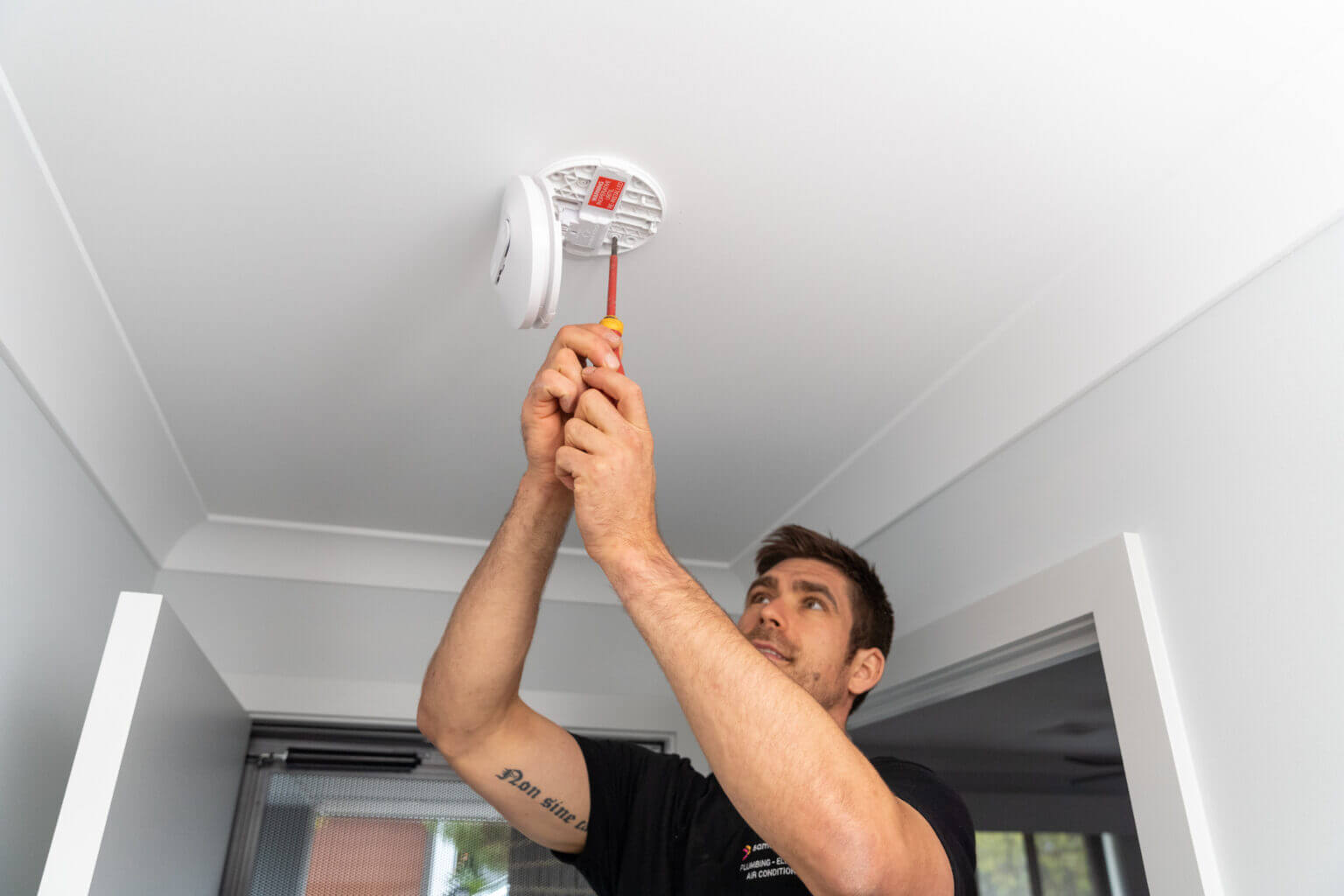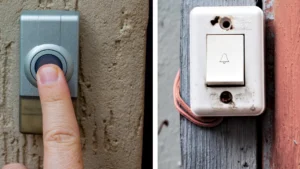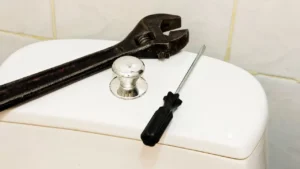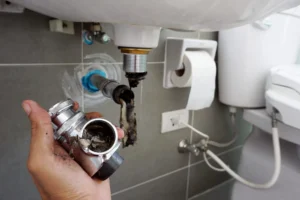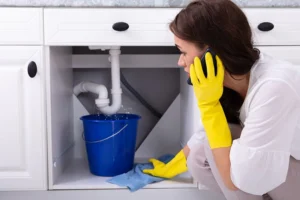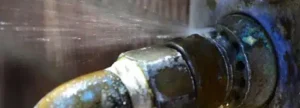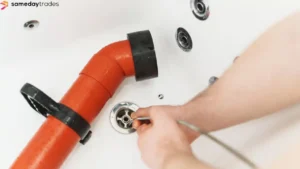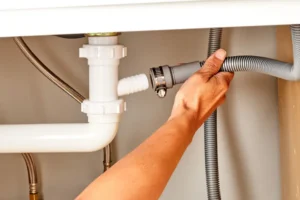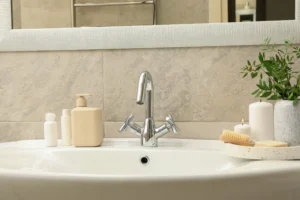Hearing your smoke detector beep can be a real headache. Surprisingly, a simple issue like a low battery can cause this annoyance. This article will guide you through stopping that pesky beep and ensuring your smoke detector functions properly again.
Are you ready to silence the noise?
Reasons why your smoke alarm is beeping?
Your smoke alarm might beep for a few reasons. It could be a low battery, dust buildup, or it’s just old and needs replacing.
Low or faulty battery
A low or faulty battery is a common reason your smoke detector keeps beeping. It’s time to replace the smoke detector battery if you hear a periodic beep. Most smoke alarms need a new battery once a year.
Make sure to use the recommended type from the manufacturer for the best results.
If, after changing the battery, your smoke alarm still beeps, it might be faulty. Try resetting the smoke detector to see if it fixes the problem. If not, you may need to replace the smoke detector entirely.
It ensures your home stays safe and sound from any fire hazards.
Dust
Dust has the potential to clog your smoke detector, causing an irritable beeping sound. Over time, dust and tiny insects may infiltrate, interfering with the sensors. Thus, to silence a smoke detector’s beeping, it requires a thorough cleaning.
Equip yourself with a gentle brush or use the gentle brush extension on your vacuum cleaner. Begin by cleaning around the exterior vents with care. Follow this by opening it up, if possible, and carefully removing any dust from within.
In order to maintain a peaceful and efficient smoke detector, include its cleaning in your routine house chores. A simple wiping with a cloth every few months works miracles; just ensure a gentle touch so as not to alter anything internally.
Another important thing: always turn off the power before initiating any cleaning! By doing so, you evade unpleasant shocks and preserve your alarm in prime functioning condition for when it’s critically needed.
Other Obstructions
Impediments in your smoke alarm may lead to unnecessary beeping. Elements such as spider webs or debris obstruct the sensor, resulting in false alarms. Hence, if the alarm rings without apparent cause, inspect for these obstructions.
A prompt clean-up may rectify the issue immediately.
Moving forward, let’s proceed with the discussion of encountering an outdated or defective device and learning how to manage it.
An old or malfunctioning device
Sometimes, a smoke detector just gets too old and starts beeping for no clear reason. Like all gadgets, smoke detectors have a life span. They usually work well for about 10 years.
After that, their sensors might not react as well as they should. This means they could beep when there’s no smoke or even fail to beep when there is. It’s a good idea to check the manufacture date on your device if it keeps beeping without cause.
If you’ve replaced batteries and cleaned the device, but it still keeps bothering you with beeps, it might just be time to replace the smoke detector entirely. Getting a new one ensures your home stays safe from fires and stops those annoying false alarms from happening.
Next up, let’s talk about humidity and how it affects your smoke alarm.
Humidity
Humidity can make a smoke detector start beeping. This happens because moisture gets inside the alarm and messes with its sensors. High humidity, like in a bathroom or kitchen, often causes this problem.
To avoid false alarms from humidity, keep your smoke alarm away from these areas.
If you find your smoke detector near places that get steamy or very damp, think about moving it. A good spot can prevent those annoying beeps caused by moisture. Next up, let’s look into some troubleshooting tips to stop that beep and keep your home safe.
Troubleshooting Tips for a Beeping Smoke Alarm
If your smoke alarm won’t stop beeping, don’t panic. Quick fixes can help, like cleaning the device or swapping out an old battery.
Clean up the alarm
A clean smoke detector works better and beeps less often for no reason. Dust can stop it from working. Here’s how to clean it properly:
- Turn off the power at your circuit breaker to make sure you’re safe.
- Gently take the smoke detector off its mounting on the ceiling or wall.
- Use a soft brush attachment on your vacuum cleaner to suck away dust and cobwebs from the outside and inside of the alarm.
- Wipe the outside of the detector with a dry microfiber cloth to catch any left-over dust.
- Get a can of compressed air and gently blow air inside the alarm, focusing on the sensor area, to clear out any hidden dust.
- Give it a few minutes to air out if you used any moisture accidentally.
- Put the smoke detector back in place and turn the power back on.
- Test the alarm using its test button to ensure it’s working right.
Cleaning is a good step in maintenance that helps keep your smoke detector alerting you only when needed.
Check for physical obstructions
Sometimes, your smoke detector keeps beeping because something is blocking it. It could be dust, cobwebs, or even small insects. Here’s how to check for and fix physical obstructions:
- Turn off the power at the circuit breaker to ensure safety before you start.
- Get a ladder or a stable chair to reach your smoke detector safely.
- Use a soft brush or a vacuum cleaner with a brush attachment to gently clean around and inside the smoke detector.
- Look inside the detector for any insects that might have crawled in and remove them carefully.
- Check the mounting bracket and surrounding area for any debris that could block smoke from entering the detector.
- Spin the detector around gently; sometimes, just repositioning it helps clear unseen obstructions.
- Make sure the vents on the smoke detector are not covered by paint or stuck-on dirt.
Done checking? Next up is replacing the battery to fully reset the smoke detector.
Replace the battery
A beep from your smoke detector often means it’s time for a new battery. Knowing how to stop this noise helps keep your home safe.
- First, find out what battery type your smoke detector needs. Most use 9V batteries, but some might need AA or AAA.
- Next, turn off the power to your smoke alarm at the main circuit breaker to ensure safety.
- Twist the smoke detector off its mounting bracket on the ceiling or wall.
- Open the battery compartment and take out the old battery.
- Check the expiration date on your new battery to make sure it’s fresh; a new, unused 9V battery should last about 3 to 5 years.
- Insert the new battery into the compartment, matching the positive and negative ends correctly.
- Close the battery compartment and put the smoke detector back on its mounting bracket.
- Turn the power back on at the circuit breaker.
- Press the test button on your smoke alarm to make sure it works with the new battery.
- Listen for a beep when you press this button; if it sounds weak, double-check that you’ve installed the battery correctly and that it’s not expired.
Swap out the batteries in all your alarms at least once a year or whenever they start beeping to prevent false alerts. This simple step could save you from annoying beeps and keep you safer at home.
Reset the alarm
Resetting your smoke alarm can often stop it from beeping. This simple step gets your detector back to its default settings. Here’s how to do it:
- Switch off the main power at the circuit breaker to ensure safety.
- Open the smoke detector cover carefully. You might need a screwdriver for this.
- Take out the battery. If your alarm has a backup battery, remove that as well.
- Press and hold the test button on the alarm for 15 to 20 seconds. Doing this drains any remaining charge and clears errors.
- Put back all batteries properly, ensuring they are fresh and correctly installed.
- Close the smoke detector cover securely.
- Turn on the main power from your circuit breaker.
- Test your smoke alarm by pressing the test button briefly; it should beep or chirp, indicating it’s working.
Doing a reset helps fix minor issues that cause beeping, like glitches or temporary malfunctions in how to stop smoke detector problems without needing to replace smoke detector units immediately unless they are old or faulty beyond repair.
How to Prevent False Alarms
To keep your smoke alarm from crying wolf, keep it clean, place it right, and steer clear of steam. Keen to learn more? Keep reading!
Regular cleaning and maintenance
Keeping your smoke alarm in top shape is vital for your safety. Regular cleaning and maintenance can help prevent false alarms and ensure it works when you need it most. Here’s a simple guide:
- Dust off the outside of your smoke detector every month. Use a soft brush attachment on your vacuum cleaner to gently remove dust and cobwebs.
- Open up the smoke alarm cover carefully. Vacuum inside to clear any dust or insects that might have gotten in.
- Check the manufacturer’s instructions for advice on how to clean the sensor chamber. Some recommend using compressed air to blow out dust.
- Replace batteries at least once a year, even if they don’t seem to be empty. Mark a date on your calendar so you won’t forget.
- Test the smoke alarm after cleaning by pressing the test button. This will tell you it’s working properly.
- Look at the date of manufacture on the back of your smoke detector. Consider replacing the entire unit every ten years or as recommended by the manufacturer.
The 7ECHAH step is straightforward but could save lives by making sure your smoke alarm is ready to alert you in case of a fire.
Proper placement of smoke alarms
To stop false alarms, it’s key to place smoke alarms correctly. They should be on every level of your home, inside bedrooms, and outside sleeping areas. Keep them away from the kitchen to avoid false alarms from cooking.
Smoke rises, so install them on ceilings or high up on walls. Avoid putting them near windows, doors, or ducts where drafts might prevent smoke from reaching the sensors.
Testing your smoke alarms monthly ensures they work right. Change batteries once a year, unless it has a 10-year battery. Replace the whole unit every 10 years or as recommended by the manufacturer.
This keeps your home safe and cuts down on those annoying beeps that seem to come out of nowhere in the middle of the night.
Avoiding humidity and steam
Keep your smoke alarm away from bathrooms, kitchens, and other steamy or humid spots. These areas can trip the alarm, making it beep for no reason. It’s a good idea to place alarms in hallways near these rooms instead.
This way, you avoid false alarms while keeping your home safe.
Next up is what to do when it’s time to call in the professionals.
When to call a professional
Sometimes, a smoke alarm keeps beeping even after you try fixing it. This is when you need to call someone who knows a lot about these devices.
Persistent beeping despite troubleshooting
If your smoke alarm keeps beeping even after trying all the fixes, it may signal a deeper issue. It’s best to get a professional in at this stage. They can look over the device and spot what’s wrong.
Often, they might find internal problems that aren’t obvious to us. Or, they might suggest it’s time for a new alarm if yours is too old.
Calling an expert ensures your smoke detector works right and keeps you safe. They’ll fix any tricky issues or help pick out and install a new one if needed. This step saves you from constant beeps and gives you peace of mind knowing everything’s checked by someone who knows their stuff.
Need for a new smoke alarm
Sometimes, a smoke alarm keeps beeping even after you’ve fixed all the problems. This could mean it’s time for a new one. Smoke alarms don’t last forever. They usually work well for about ten years.
After that, they might not spot smoke or fire quickly enough. It’s like how a car gets less reliable as it gets older.
You should also think about getting a new smoke alarm if yours doesn’t have the latest features. New models can tell the difference between real danger and something simple like burnt toast.
Plus, they’re better at waking you up if there’s a fire at night because they use louder and more effective alarms.
Expert assessment and installation
After deciding that a new smoke alarm is needed, it’s smart to get professional advice and fitting. Experts know exactly where and how to set up smoke alarms for the best safety. They look at your home, figure out the right spots for the alarms, and install them correctly.
This means they work well when you need them most.
Calling in professionals also makes sure your alarms meet all legal requirements. In Australia, laws are strict about where smoke detectors must be placed in homes. Pros have this knowledge at their fingertips.
They can guide you through choosing the best type of alarm for each area of your house. This helps avoid false alarms from steam or cooking fumes. Safe installation by an expert can give you peace of mind, knowing your family is protected against fire risks with top-notch equipment that’s put in place perfectly.
Recommended Smoke Detectors and Electrical Services
Finding a good service for your smoke detector and electrical needs can make all the difference. It’s about getting someone who knows their stuff, from fitting new alarms to fixing any electrical issues that might cause false beeps.
Look for services with solid reviews, years of experience, and proper certification. They should offer everything, from installation to maintenance. This way, you get peace of mind knowing your home is safe.
Some companies specialise in both general electrical work and smoke alarm expertise. They can give you advice on the best type of detector for your house and where to place it. Plus, they often provide yearly check-ups to ensure everything works as it should.
Choosing such a service keeps you one step ahead—making sure beeps only happen when there’s real smoke.
Conclusion
Stopping a beeping smoke detector can seem like a tricky task, but it’s pretty straightforward with the right steps. First off, check if it needs a new battery or a good cleaning. Sometimes, dust or little bugs get in the way.
If those fixes don’t work, it might just be old and need replacing. For peace of mind, getting help from an expert makes sense when things get too complex. So there you have it—with some quick checks and regular upkeep, keeping your home safe and sound is easier than you might think!

